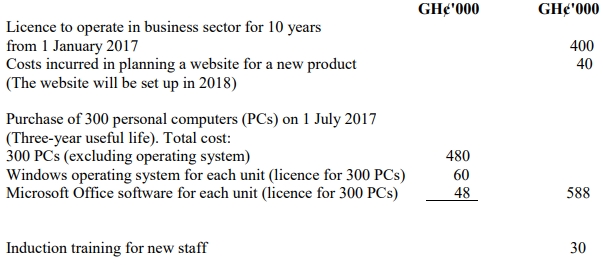- 7 Marks
FR – Nov 2024 – L2 – Q2c – Intangible Assets and Their Measurement
Determining the correct accounting treatment for various intangible assets in Dolo LTD's financial statements, including licensing, software, and book rights.
Question
Question:
Dolo LTD, a market leader in the pharmaceutical industry, incurred the following expenditures during the financial year ended 31 December 2023:
| Expenditure Item | Amount (GH¢’000) | Additional Information |
|---|---|---|
| Licence to operate in the pharmaceutical industry (10-year validity from January 2023) | 200 | Intangible asset |
| Costs incurred in setting up a website for a new product | 20 | The website will be developed in 2024 |
| Purchase of 295 personal computers on 1 July 2023 (three-year useful life) | 840 | Excludes software costs |
| Windows operating system (for 295 PCs) | 530 | Perpetual software license |
| Microsoft Office software (for 295 PCs) | 24 | Three-year software license |
| Induction training for new staff | 430 | Staff training for new hires |
| Book rights purchased from another entity a few years ago | 90 | The rights have an indefinite useful life |
| Independent valuation of book rights as of 31 Dec 2023 | 240 | Valued by an independent expert |
Dolo LTD’s policy is to use the revaluation model for intangible assets where a market valuation is available.
Required:
Determine the carrying amount of intangible assets at 31 December 2023, in accordance with IAS 38 – Intangible Assets and IFRS.
Find Related Questions by Tags, levels, etc.
- Tags: Amortization, Capitalization, IAS 38, Intangible Assets, Licensing, Revaluation Model, Software Costs, Valuation
- Level: Level 2
- Topic: Financial Reporting Standards and Their Applications
- Series: Nov 2024


